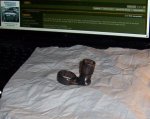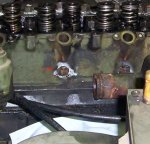mckeeranger
Member
- 779
- 4
- 18
- Location
- Eastern Kentucky
Well, the home made tool worked perfectly. The heads are back on and torqued to specifications.
The biggest obstacle wasn't the oil cooler, it was the clearance around the head nuts on the front head. The stud isn't centered in the space, so the wrench wouldn't fit down on the nut. I ended up "adjusting" the thickness of the boxed-end wrench to make it fit. The rear head had plenty of room, as the studs were in the center of the space.
Now I just need to put the rest of the engine back together. I wish I had time to detail it, but I'm having to put it back together dirty and unpainted. I have tomorrow to get it together, then my next day off isn't until the parade I'm trying to make down in London KY on Oct. 9th.
A good steam bath and it will look fine.
The biggest obstacle wasn't the oil cooler, it was the clearance around the head nuts on the front head. The stud isn't centered in the space, so the wrench wouldn't fit down on the nut. I ended up "adjusting" the thickness of the boxed-end wrench to make it fit. The rear head had plenty of room, as the studs were in the center of the space.
Now I just need to put the rest of the engine back together. I wish I had time to detail it, but I'm having to put it back together dirty and unpainted. I have tomorrow to get it together, then my next day off isn't until the parade I'm trying to make down in London KY on Oct. 9th.
A good steam bath and it will look fine.
Attachments
-
63.5 KB Views: 117
-
81.4 KB Views: 122







